10 Best Python Books – Tame This Programming Creature (Spring 2023)
Compilation of the best Python books, from beginner and kids to advanced level.
Did you know that Python programming language is named after the British comedy group Monty Python but has nothing to do with snakes? Its creator, Guido van Rossum, was a big fan of the group.
If you’re just starting to learn Python or are looking to improve your skills, the best Python books can help. We reviewed 30 products to find 10 outstanding books with the Python Crash Course as our Editor’s Choice. We made sure they were all written by experts in the field. We also included books for different levels of experience, from beginner to expert, and even for kids. The next criterion we looked at was the ease of use. The books on our list are all well-organized and easy to follow. They also include helpful coding exercises and sample projects.
| Name | Nomination | Overall rating |
|
This book is an up-to-date, project-based guide to Python programming that will teach you to write programs, solve challenges, build computer games, and work with visualization |
Editor’s Choice | 9.9 |
|
It is a comprehensive and thorough manual that will help you take full advantage of Python’s capabilities |
Best for Advanced Coders | 9.8 |
|
3. Python Programming for Beginners This book covers everything you need to know to get up and running with Python, from installation to writing your first program |
Best for Beginners | 9.7 |
|
4. Learn Python in One Day and Learn It Well With all the basics covered in this book, you’ll be up and running in no time – and with a project at the end of the book, you’ll have plenty of practice too |
Best Project-Based |
9.6 |
|
5. The Big Book of Small Python Projects With 81 fun challenges in this book, you’ll work on digital art, games, animations, and more to improve your coding skills |
Best Practice | 9.5 |
|
This book is a lighthearted introduction to the Python programming language that’s chock full of fun examples, projects, and quizzes |
Best for Kids | 9.4 |
|
7. Python Data Science Handbook This book is a guide to the data science toolkit that Python provides, including IPython, NumPy, Pandas, Matplotlib, and Scikit-Learn |
Best for Data Science | 9.3 |
|
8. Python Programming for Beginners This affordable book is a quick and effortless way to learn Python and its syntax so that you can easily start using it, even if you have no programming experience |
Best Value | 9.2 |
|
This comprehensive book is for intermediate Python developers who want to learn how to write efficient, maintainable code |
Best for Intermediate Coders | 9.1 |
|
10. Learn Python 3 the Hard Way This book will teach you everything you need to know in order to write basic programs in Python 3, all while making sure that you have fun doing it |
Best Python 3 Book | 9.0 |
Detailed Product Reviews
Features:
- Author: Eric Matthes
- Edition: 2nd
- Publisher: No Starch Press
- Page count: 544
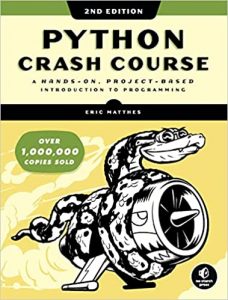
Python Crash Course was chosen as our Editor’s Choice because it is a fast, in-depth, and easy way to learn Python. This book will guide you through the process of building programs with Python from the ground up, starting with basic syntax and control flow structures and ending with advanced topics like networked services, web scraping, and database integration. Clear explanations and examples make learning Python a breeze, even if you have zero experience in programming. Moreover, the book is up-to-date and project-based which means you will quickly gain a practical understanding of programming concepts and techniques.
The Python Crash Course book starts from the basics like variables and classes before moving on to more complex topics. It’s more comprehensive than the Learn Python 3 The Hard Way book later on our list, which focuses only on learning Python 3. If you want a quick course in Python without focusing on a single version, then the Python Crash Course is ideal for you. It is also suited for beginners and covers Django, Plotly, Matplotlib, and Pygame.
What we liked
- Project-based;
- Quick and easy to learn;
- Teaches to write programs, solve problems, build computer games, and work with visualization;
- Exercise-based approach;
- Clear explanations and examples;
- Great for people with zero experience in programming;
- Up-to-date;
- Covers Django, Matplotlib, Plotly, and Pygame.
What could be better
- Some buyers have issues with the book spine.
Features:
- Author: Mark Lutz
- Edition: 5th
- Publisher: O’Reilly Media
- Page count: 1643
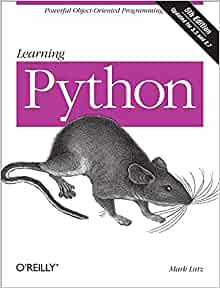
Learning Python from Mark Lutz is the authoritative resource for Python programming. It is a comprehensive tutorial and reference that will prove invaluable to programmers moving from other languages to Python, as well as to Python experienced developers interested in deepening their understanding of the language. A carefully crafted blend of theory, examples, and practical advice shows you how to write elegant code with Python. You’ll learn about basic concepts and tools, work with fundamental data structures, manipulate text, numbers, and dates, and master larger projects.
Advanced users who want an in-depth introduction to Python can consider the Learning Python book. It’s quite similar to the Python Crash Course that we mentioned as our Editor’s Choice since they are both comprehensive. But the Learning Python book is better suited for developers that are well-versed in other languages and want to start learning Python, unlike the Python Crash Course which offers a quick lesson for beginners in general. The Learning Python book is three times as large as the Python Crash Course too, so it is more in-depth for developers.
What we liked:
- Hands-on approach;
- Comprehensive and thorough content;
- Presenting advanced Python features;
- Covers 2.7, 3.3, and other popular Python versions;
- Clear examples.
What could be better:
- Huge;
- Not for novices.
Features:
- Author: Codeone Publishing
- Edition: not specified
- Publisher: Independently published
- Page count: 125
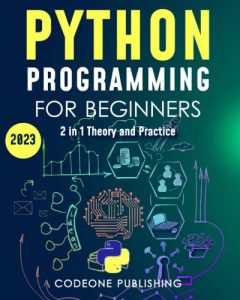
Python Programming for Beginners from Codeone Publishing is the perfect introduction to one of the most popular programming languages in the world. This book will teach you everything you need to know to get started with Python, from installing it and setting up your development environment, to working with data types and variables, manipulating strings, creating loops and conditionals, implementing program flow controls, and more. The book also teaches you how to program according to the Object-Oriented paradigm.
Unlike the Learning Python book, which claimed the second position on our list, the Python Programming for Beginners book is better suited for beginners that barely know anything about programming. It offers simplicity, making it ideal for those who are just getting started. There is systematic guidance on carefully selected topics, practice exercises, and examples that help you recollect your knowledge. Unlike the Learning Python book which has 1500+ pages, the Python Programming for Beginners only has about 125, making it a quick read for those getting started.
What we liked:
- Simple explanations;
- Gradual step-by-step organization;
- A lot of practice and examples;
- Excellent for absolute beginners in programming;
- Up-to-date;
- Covers object-oriented programming and exceptions.
What could be better:
- Some buyers found typos in the text.
Features:
- Author: Jamie Chan
- Edition: 2nd
- Publisher: CreateSpace Independent Publishing Platform
- Page count: 174
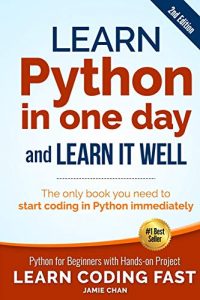
Learn Python in One Day and Learn It Well from Jamie Chan will take you from knowing nothing about Python to writing your own programs and applications. You’ll learn how to create variables, work with data types, format strings, accept user inputs and display outputs, control the flow of your program with loops, handle errors and exceptions, and more. The book also includes a section on object-oriented programming. In addition, it includes a project at the end, so you can put your new skills into practice.
The Learn Python in One Day and Learn It Well book is as comprehensive as the Python Crash Course book, and both are suitable for beginners with a wide range of examples and special features. But, if you learn better with hands-on practice, then you should choose the Learn Python in One Day and Learn It Well book because it comes with a project at the end that helps you practice every single thing that you have read. It helps you learn by doing.
What we liked:
- Covers object-oriented programming;
- Affordable price;
- Easy to understand;
- Good for beginners;
- Helpful examples;
- Well-organized;
- The book offers a project where you can apply your new skills and knowledge obtained from the book.
What could be better:
- Small.
Features:
- Author: Al Sweigart
- Edition: not specified
- Publisher: No Starch Press
- Page count: 432
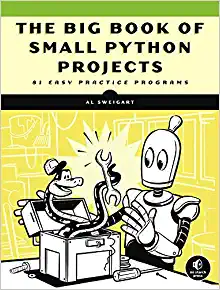
If you’ve mastered basic Python syntax and you’re ready to start writing programs, you’ll find The Big Book of Small Python Projects both enlightening and fun. This collection of 81 Python projects will have you making digital art, games, animations, counting programs, and more. Once you see how the code works, you’ll practice re-create the programs and experiment by adding your own custom touches. This book is undoubtedly the best way to have some practice and sharpen your Python skills.
The Big Book of Small Python Projects is best suited for those that only want to write programs, as they already know the syntax. It is a fun book that is perfect for beginners, but unlike Python Programming for Beginners, which is number three on this list, it has a wide range of practice exercises and text-based programs that you can use to learn. Python Programming for Beginners also has a practice exercise, but not as extensive as this one, and it is more suitable for those who don’t know the basic syntax. However, if you do, consider the Big Book of Small Python Projects.
What we liked:
- Variety of interesting and inspiring projects;
- Practice makes perfect;
- You’ll work on games, digital art, animation, and more;
- Suitable for beginners.
What could be better:
- The book has no theoretical part and suggests you already have some knowledge of Python syntax.
Features:
- Author: Jason R. Briggs
- Edition: 1st
- Publisher: No Starch Press
- Page count: 344
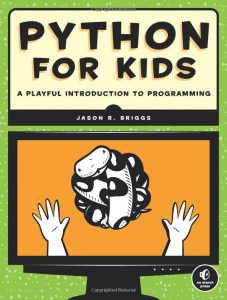
Python for Kids is a fun, easy-to-read introduction to the Python programming language for kids aged 10 and up. This book uses hands-on exercises to teach young readers the basics of programming, from creating lists of data to making simple games and animations. Python for Kids is perfect for budding programmers, parents who want to learn coding with their kids, or anyone who wants to learn more about Python language. You don’t need any previous knowledge of programming or computers—all you need is curiosity.
The Python for Kids book is suitable for kids, as per the name, and also for anyone who wants to learn about Python language without any previous tech knowledge. It’s similar to the Big Book of Small Python Projects because they are both designed with fun exercises and examples that will bring Python to life. But, the Big Book of Small Python Projects is for those who already know the basics, while the Python for Kids book allows you to learn even if you know nothing at all.
What we liked:
- Colorful illustrations;
- Learning through playing;
- Interesting and simple way of presenting;
- By the end of the book, you are going to create two games.
What could be better:
- Some buyers would like to see more examples.
Features:
- Author: Jake VanderPlas
- Edition: 1st
- Publisher: O’Reilly Media
- Page count: 546
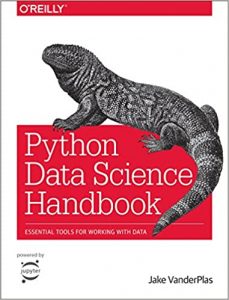
The Python Data Science Handbook is the go-to guide for Python developers and data scientists who want to use their existing skills with Python to start working on real problems in data science. It’s also a great resource for experienced data scientists looking to learn about using Python as a tool for their trade. You’ll learn how to use IPython and Jupyter, NumPy, Pandas, Matplotlib, and Scikit-Learn. With this handbook, you’ll be able to efficiently store and manipulate data using Python.
If you need a Python book in relation to data science, this is suitable for you. It is suitable for data scientists and crunchers. The Python Data Science Handbook provides a more specific knowledge base unlike the Python Crash Course that we named our Editor’s Choice, which is more general. If you need a reference for scientific computing in Python, choose the Python Data Science Handbook, but if you want an all-around explanation, then the Editor’s Choice is a better option.
What we liked:
- Teaches to work with IPython, NumPy, Pandas, Matplotlib, and Scikit-Learn;
- A great number of illustrations and examples;
- Easy to follow.
What could be better:
- The illustrations are all black and white.
Features:
- Author: Andrew Park
- Edition: not specified
- Publisher: Independently published
- Page count: 114
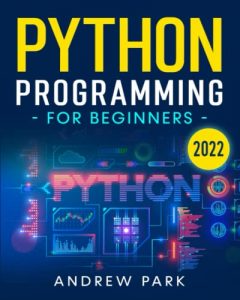
Python Programming for Beginners is a concise and easy-to-understand introduction to the fundamentals of Python programming. The book starts with an overview of what Python is, its history, where it came from, and why it is so popular today. It then goes on to explain how you can install Python and what are the best distributions, whether you use Windows or Mac. Finally, all objects and methods (including OOP) in Python are exposed logically and sequentially, so that you will be effectively able to use this user-friendly language.
You don’t have to break the bank to learn about Python Programming for Beginners, as it comes at an affordable price. It is also a short book, much shorter than Python Programming for Beginners (Codeone Publishing) which is the third option on our list. Although both are for beginners, you can spend less and get simplicity with this option. It also comes with examples and carefully selected topics. If you’re saving money, choose this Python Programming for Beginners book.
What we liked:
- Beginner-friendly;
- Affordable price;
- Up-to-date;
- Carefully-selected topics;
- Written in simple language;
- Examples and exercises.
What could be better:
- Small.
Features:
- Author: David Beazley, Brian Jones
- Edition: 3rd
- Publisher: O’Reilly Media
- Page count: 704
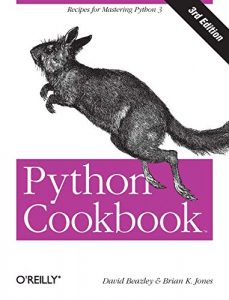
Being a comprehensive guide to intermediate Python programming, this book covers a wide range of topics from data structures and algorithms to strings and text processing to network and web programming. With over 700 pages of code examples, it’s an essential resource for any Python programmer. Each recipe contains the problem statement, solution code in Python, and an explanation of how it works. These simple recipes are designed to be easy to read so that you can quickly get up to speed on a new topic or brush up on your skills.
If our second option, Learning Python, is too advanced and long for you, but the Python Programming for Beginners, which we reviewed thirdly, is too elementary, then you’re an intermediate coder. You can consider the Python Cookbook instead, which is suitable for those who already know the basics and want to start advancing on Python. All the recipes are based on Python 3.3 too, so you need to have previous knowledge before you start reading.
What we liked:
- Covers Python 3;
- Up-to-date programming technics.
What could be better:
- Not for newbies.
Features:
- Author: Zed Shaw
- Edition: 1st
- Publisher: Addison-Wesley Professional
- Page count: 320
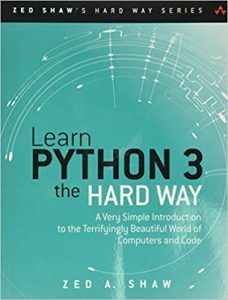
If you’re looking for a comprehensive guide to Python 3, look no further than Learn Python 3 the Hard Way. Author Zed Shaw provides in-depth instruction and plenty of exercises to help you build your skills. Learn Python 3 the Hard Way covers everything from installing a Python environment to writing your first program. You’ll learn how to work with variables, strings, and text, interact with users, loop, and logic. You’ll also learn data structures using lists and dictionaries, and how to use object-oriented programming techniques.
If you already know Python 2, it’s best to learn Python 3 with the Learn Python 3 the Hard Way book. The in-depth book focuses mostly on Python 3 and is more specific than the Learning Python book, second on our list. The latter teaches Python 2.7 and 3.3, but if you already know 2.7 and want to study Python 3 more thoroughly, you should opt for Learn Python 3 the Hard Way. It comes with a wide range of topics and a video where you learn how to break, fix and debug code.
What we liked:
- 52 effective exercises;
- Suitable for novices;
- Well-organized structure;
- Accompanying videos.
What could be better:
- Some buyers have issues with the paper quality.
Things to Consider
Python is a versatile language that you can use for everything from web development to data science. In fact, it is one of the most popular languages on the planet. However, before you can start using it, you need to learn the basics. The best way to do that is with a good book.
About Python
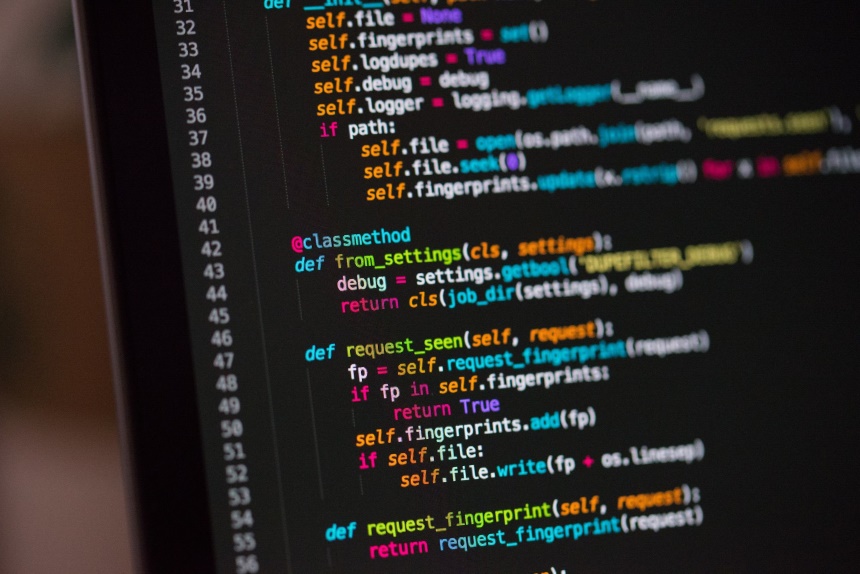 Python is a high-level, interpreted, general-purpose programming language, created on December 3, 1989, by Guido van Rossum, with a design philosophy, entitled
Python is a high-level, interpreted, general-purpose programming language, created on December 3, 1989, by Guido van Rossum, with a design philosophy, entitled
“There’s only one way to do it, and that’s why it works.”
In the Python language that means explicit is better than implicit.
Python is a versatile scripting language for automating tasks, powering major sites like Google and Instagram. It’s also popular for data science and scientific computing, thanks to libraries like NumPy and Pandas. You can even use it for simple things like making a basic calculator program.
Python is characterized by a simple syntax, modular programming, easy readability, and understandable code. It’s no wonder that it has been termed “executable pseudocode” by some. The Python language is also relatively forgiving when it comes to errors, which makes it a great choice for beginners.
Python is sometimes described as an object-oriented programming language. That means it uses a model of objects and classes, which you can use to structure your code in a way that’s easy to understand and reuse.
Python Advantages
Although Python has been around for almost 30 years, it’s only recently that it has become so popular. That’s because the language has a lot to offer in terms of productivity and ease of use.
First, Python is an interpreted language. That means you don’t need a separate program to compile your code before you can run it. You can simply use a Python interpreter to run your Python code on any computer, without having to install anything.
Second, Python is a high-level language. That means it’s closer to human languages like English than low-level languages like Assembly. As a result, Python code is easy to read and understand. It’s also easy to write, even for people who don’t have a lot of experience with coding.
If you’re new to coding, Python is a great language to learn. It’s easy to use and understand, and it has a huge community of developers who can help you if you get stuck.
Third, Python is a versatile language. You can use it for everything from web development to data science. In fact, it’s one of the most popular languages on the planet.
Fourth, Python has a large standard library. That means there are already a lot of functions and modules available for you to use. You don’t have to write everything from scratch, which saves a lot of time.
If you’re an experienced programmer, Python can be a powerful tool for automating tasks, powering major sites, and even doing data science. So whatever your level of experience, Python is worth learning.
Finally, Python is an open source. That means anyone can contribute to the development of the language. As a result, there’s a huge community of developers who are always working to improve Python.
FAQ
What data types are used in Python?
There are various data types in Python. The most common ones are integers (int), floats (float), strings (str), booleans (bool), lists (list), tuples (tuple), dictionaries (dict).
What is the difference between Python and JavaScript?
The main difference is that Python is a scripting language while JavaScript is a programming language. With Python, you can write code that will be executed line by line as the program runs. With JavaScript, you write code that will be compiled into a single file, which can be executed all at once. Another difference is that Python is a dynamically typed language while JavaScript is a statically typed language. In Python, you don’t have to declare the types of variables before using them. Finally, Python is an interpreted language while JavaScript is a compiled language. With Python, you can run your code without having to compile it first.
What are some of the most popular libraries for Python?
Some of the most popular libraries for Python include NumPy, Pandas, Matplotlib, and Scikit-learn. These libraries are used for a variety of tasks, including data analysis, machine learning, and scientific computing.
Our Verdict
Our Editor’s Choice, Python Crash Course from Eric Matthes, will help you quickly get up and running, even if you are new to programming. You’ll learn the basics of how to write programs using Python, how to work with data structures, how to create and use your own modules, and more.
The second best Python book is Learning Python by Mark Lutz. This hands-on book is ideal for experienced programmers migrating from other languages. This comprehensive tutorial will teach you how to write programs in Python like a pro.
Python Programming for Beginners from Codeone Publishing will take you from a complete novice to a competent Python programmer in gradual, simple steps. This up-to-date manual covers object-oriented programming and exceptions. It also contains a lot of practice and examples to help you learn.
